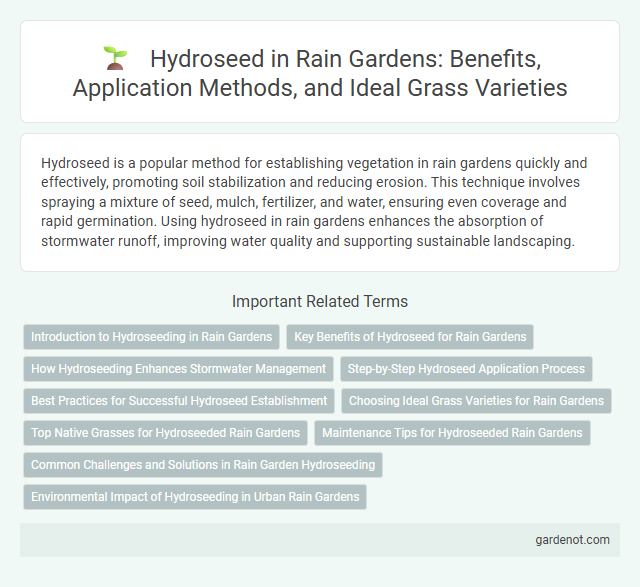Hydroseed is a popular method for establishing vegetation in rain gardens quickly and effectively, promoting soil stabilization and reducing erosion. This technique involves spraying a mixture of seed, mulch, fertilizer, and water, ensuring even coverage and rapid germination. Using hydroseed in rain gardens enhances the absorption of stormwater runoff, improving water quality and supporting sustainable landscaping.
Introduction to Hydroseeding in Rain Gardens
Hydroseeding in rain gardens involves spraying a mixture of seed, mulch, fertilizer, and water to promote rapid vegetation establishment on erosion-prone areas. This technique enhances soil stabilization and improves water infiltration, reducing runoff and filtering pollutants effectively. Hydroseeding accelerates plant growth, making it an efficient and cost-effective method for sustainable rain garden development.
Key Benefits of Hydroseed for Rain Gardens
Hydroseed enhances rain gardens by promoting rapid vegetation growth through a slurry of seeds, mulch, fertilizer, and water, ensuring effective soil stabilization. It improves erosion control by quickly establishing dense plant cover, which reduces runoff and filters pollutants from stormwater. The cost-effective application and uniform seed distribution maximize plant diversity and resilience in rain garden ecosystems.
How Hydroseeding Enhances Stormwater Management
Hydroseeding significantly improves stormwater management by promoting rapid vegetation growth that stabilizes soil and reduces erosion. The mixture of seed, mulch, fertilizer, and water creates a protective layer, enhancing infiltration and minimizing surface runoff. This method efficiently filters pollutants and supports the natural absorption of rainwater, reducing the burden on drainage systems.
Step-by-Step Hydroseed Application Process
Hydroseed application in rain gardens begins with site preparation, including soil grading and removal of debris to ensure proper drainage and seed-to-soil contact. The hydroseed mixture, containing seed, fertilizer, mulch, and water, is uniformly sprayed onto the prepared soil using specialized equipment for optimal coverage. After application, regular watering and monitoring promote fast germination and healthy plant establishment, enhancing rain garden performance in stormwater management.
Best Practices for Successful Hydroseed Establishment
Hydroseed application for rain gardens requires precise seed selection tailored to local climate and soil conditions to ensure optimal germination and growth. Applying a uniform slurry mixture consisting of seed, mulch, fertilizer, and tackifier promotes soil moisture retention and erosion control during establishment. Regular monitoring and supplemental watering during the initial 3 to 6 weeks are critical for successful seedling development and long-term rain garden sustainability.
Choosing Ideal Grass Varieties for Rain Gardens
Selecting grass varieties for rain gardens requires considering drought tolerance, root depth, and sediment filtration capabilities. Native grasses like Blue Grama, Switchgrass, and Little Bluestem efficiently absorb rainwater while stabilizing soil and preventing erosion. Incorporating species with dense root systems enhances water infiltration and supports the rain garden's ecological function.
Top Native Grasses for Hydroseeded Rain Gardens
Top native grasses for hydroseeded rain gardens include little bluestem (Schizachyrium scoparium), switchgrass (Panicum virgatum), and prairie dropseed (Sporobolus heterolepis). These species are well-adapted to local climate conditions, provide excellent erosion control, and enhance water infiltration in rain garden systems. Choosing native grasses promotes biodiversity and sustains the ecological balance of stormwater management landscapes.
Maintenance Tips for Hydroseeded Rain Gardens
Hydroseeded rain gardens require regular watering to ensure seed germination and soil stability, especially during the first few weeks after planting. Monitoring for erosion and reseeding bare spots promptly helps maintain optimal coverage and prevents runoff. Periodic mulching and removing invasive weeds support healthy plant growth and long-term rain garden functionality.
Common Challenges and Solutions in Rain Garden Hydroseeding
Hydroseeding in rain gardens often faces challenges such as uneven seed distribution, soil erosion, and poor seed-to-soil contact, which can hinder plant establishment. Solutions include using a mix of mulch and tackifiers to stabilize the soil, selecting drought-resistant native plant seeds to improve germination success, and applying hydroseed in optimal weather conditions to reduce washing away and promote growth. Proper site preparation and regular monitoring ensure the rain garden achieves effective water absorption and pollutant filtration.
Environmental Impact of Hydroseeding in Urban Rain Gardens
Hydroseeding in urban rain gardens promotes rapid vegetation establishment, reducing soil erosion and surface runoff that contribute to urban flooding. The use of native seed blends enhances biodiversity and improves water infiltration, mitigating pollutants in stormwater before it reaches waterways. This sustainable planting method minimizes the need for chemical fertilizers and pesticides, supporting healthier urban ecosystems and air quality.
Hydroseed Infographic

 gardenot.com
gardenot.com